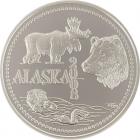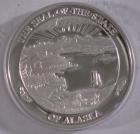The 2008 Alaska Wildlife Medallion


The medallion features a moose, a bear and an otter.
Click images for a detailed view
The design is from a drawing by Alaskan artist P. Vargas.
Total one ounce proof mintage: 3,875
Total Two ounce proof mintage: 52
Current List Price $225.00
Our Price $195.00
The moose (Alces alces) is the world's largest member of the deer family. The Alaska race (Alces alces gigas) is the largest of all the moose. Moose are generally associated with northern forests in North America, Europe, and Russia. In Europe they are called "elk." In Alaska, they occur in suitable habitat from the Stikine River in the Panhandle to the Colville River on the Arctic Slope. They are most abundant in recently burned areas that contain willow and birch shrubs, on timberline plateaus, and along the major rivers of Southcentral and Interior Alaska.
Brown bears (Ursus arctos) occur throughout Alaska except on the islands south of Frederick Sound in southeastern Alaska, the islands west of Unimak in the Aleutian Chain, and the islands of the Bering Sea. They also occur in Canada, Asia, Europe, and in limited numbers in a few western states. Brown bears are very much a part of the Alaska scene and are a favorite topic with most hunters, hikers, photographers, and fishers.
The sea otter (Enhydra lutris) lives in shallow water areas along the shores of the North Pacific. Its range once extended from southern California north then west through the Aleutian Islands, to the Kamchatka Peninsula, and south to the northern islands of Japan. In 1742, Vitus Bering's men returned with sea otter pelts from the historic voyage of discovery of Alaska. Interest in these rich furs initiated an era of exploitation which almost wiped out the sea otter.
The above information is from the Alaska Department of Fish and Game.
A complete information sheet comes with each medallion.
